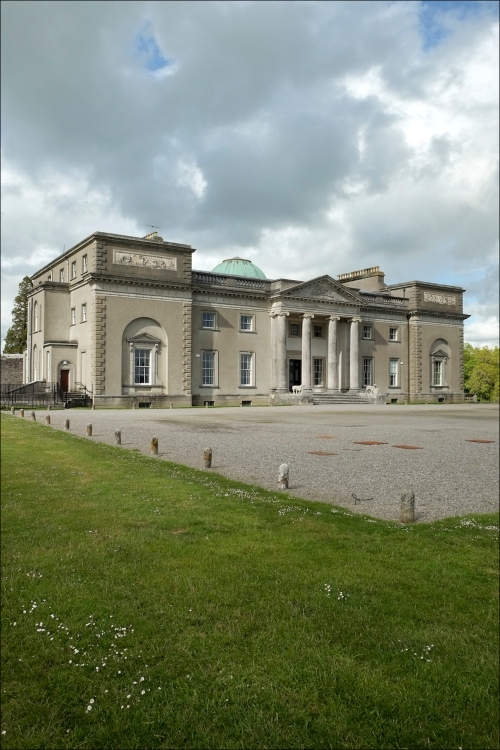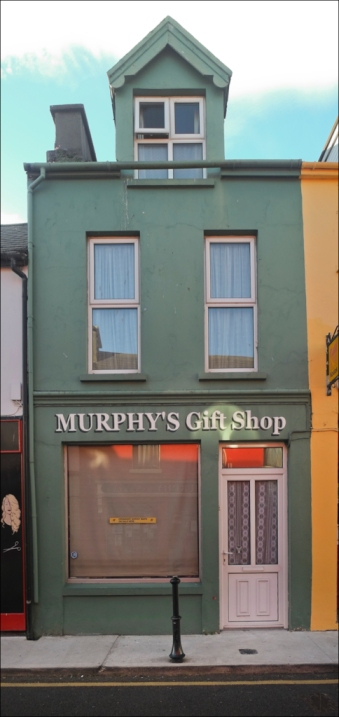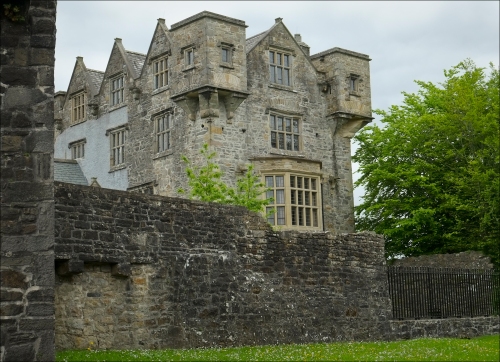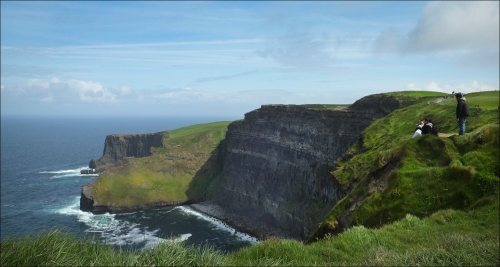We visited Edinburgh 20 years ago and a lot has changed since then. There seems to be construction projects everywhere and yet it’s core appears relatively in tact with the exception of a hoard of new tourists from every corner of the globe.. During our first visit, traveling in Europe was still pretty much the purview of Americans, Canadians, Australians and other Europeans with just a smattering of folks from more distant locales. Now, in the new global economy, everyone has hit the road. Asians, Africans, Middle Easterners and South Americans all fill the streets to catch a glimpse of Europe’s cultural past. Crowded as it may be, this is still a wonderful city with much to see and do.

Dr. Thomas Chalmers Looks Towards Edinburgh Castle – New Town

Sir Walter Scott Monument – New Town

George IV Statue – New Town
The cultural center of the city is divided into two distinct areas, the Old Town which sits upon Castle Rock and the New Town in the valley directly below. Prior to the mid 1700s, Edinburgh was probably not a place anybody from the 21st century would want to visit. It consisted of a long market street, now the Royal Mile, stretching along the spine of the rock up to the castle at the top.

The Royal Mile – Old Town

Old Town

The Royal Mile – Old Town

The Royal Mile – Old Town

Old Town

The Scotsman – North Bridge – Old Town
The narrow side alleys or closes ran perpendicular to the main street and snaked through the tall tenement buildings to the valley below. The buildings facing the market street were filled cheek to jowl with rich and poor alike. With absolutely no sanitation, sewage ran freely down the closes and culminated in a stagnant pond, i.e. cesspool, at the bottom of the hill. The city was a nasty and often dangerous place, filled with disease and rats. The slums were considered the worst in Europe and it is said that you could smell them from 12 miles away.

Advocates Close – Old Town

Old Town

Roxburgh’s Close – Old Town

Gladstone House – Old Town – Scottish National Trust

Riddle’s Close – Old Town

Riddle’s Close – Old Town

Riddle’s Court – Old Town

Wardroom’s Court – Old Town
This all changed in 1776 when a young architect named Jame Craig was selected to design a New Town in the area to the Northland below the old city. Over the next two decades the new grid layout filled with Georgian townhouses for the rich and fashionable and gave Edinburgh a whole new start, allowing it to be dubbed “the Athens of the North”.

The Albert Memorial in Charlotte Square – New Town

Georgian Townhouses

Georgian Townhouse

The Georgian House – Scottish National Trust

The Georgian House – Scottish National Trust
Over the past few years Wendi and I have been fortunate enough to see some great art in some of Europe’s most outstanding museums. Edinburgh, like all great European capitals, has it’s share. We have been to the Scottish National Gallery and the Scottish National Portrait Gallery this week and they are both amazing buildings filled with stunning works of art.

Scottish National Gallery

The view from Scottish National Gallery

Scottish National Gallery

Robert Burns at the National Portrait Gallery
Although I am consistently moved and inspired by so much of the art, the things that I have find most compelling and captivating are the amazing stories of the creators and the subjects they have chosen to depict.
Aye, so you think you love your wee doggie do you.

“Callum” – John Emms – 1895
Meet Callum, an adorable little Dandie Dismount terrier who was owned by James Cowan Smith. The Honorable Mr. Smith commissioned English artist John Emms to paint his beloved dog in 1895. In 1919 the Smith estate bequeathed £55,000 to the Gallery. This was an astronomical sum at the time, a legacy that allowed the purchase of John Constable’s Dedham Vale, Singer Sargent’s Lady Agnew and Goya’s El Medico. There was only one condition, the Gallery had to agree to permanently display Emm’s portrait of Callum. A promise it has keep for almost 100 years.

“Lady Agnew of Lochnaw” – John Singer Sargent – 1892
The American painter John Singer Sargent spent the vast majority of his life living and working in Europe and became hugely successful in his lifetime. After securing a commission through negotiations which he carried out personally, Sargent would visit the client’s home to see where the painting was to hang and would often review a client’s wardrobe to pick suitable attire. He often worked in his studio, which was well-stocked with furniture and background materials he chose for proper effect. He had no assistants and handled all the tasks, such as preparing his canvases, varnishing the painting, arranging for photography, shipping, and documentation himself. He commanded about $5,000 per portrait, or about $130,000 in current dollars. Some American clients traveled to London, at their own expense, to have Sargent paint their portrait. It all sounds good but the road was not without it’s bumps. When his most controversial work, Portrait of Madame X, now considered one of his best, was unveiled in Paris at the 1884 Salon, it aroused such a negative reaction that it is thought to have prompted Sargent’s move to London. Strange, given that the English critics were particularly harsh to him, calling his technique “Frenchified” with “no taste in expression, air, or modeling.” But all scandal disappeared in 1893 when this painting, the Lady Agnew, was exhibited at the Royal Academy. It’s critical success allowed Sargent to average as many as fourteen portrait commissions per year during the 1890s. If my math serves me right that’s a couple million a year. Not bad for a boy with almost no formal education other then a constant diet of museums and an odd assortment of art tudors.

“Winter Day, Finzean” – Joseph Farquharson – 1901
Besides being the Laird of Finzean in Aberdeenshire, Joseph Farquharson was a successful professional painter. He built a movable hut on wheels with allowed him to set up throughout his beautiful wooded estate and capture, en plein-air, the snowy landscapes that made him famous. Unlike this painting, much of his work contained the sheep that populated the estate, which prompted the nickname, “Frozen Mutton Farquharson”.

“The Comforts of Industry” – George Morland – 1780s

“The Miseries of Idleness” – George Morland – 1780s
Clearly English painter George Moreland knows his subject matter. By way of comparison, these two companion pieces illustrate the benefits of an orderly and industrious life as opposed to the shortcomings of a drunken and slovenly life. Ironically Moreland died bankrupted of alcoholism at the relatively young age of 41.

“Portrait of Sarah Malcolm” – William Hogarth – 1733
I guess you’d have to call this painting a spec job because I’m certain that Sarah didn’t commission it. She is shown here in her cell at Newgate Prison just two days before her execution for the murder of her mistress Lydia Buncombe and two fellow servants. Celebrated writer and collector Horace Walpole purchased the painting from the artist.
“The world is a tragedy to those who feel, but a comedy to those who think” – Horace Walpole

“The Three Legends of St. Nicholas” – Gerard David – 1500-20
We investigated the life and legends surrounding St. Nicholas while in Holland last December for the Sinterclaus celebration. This is the first artwork we’ve seen depicting the original Santa Claus’ legend and miracles. In the left panel the future Saint stands in a wash basin thanking God for his birth, certainly an early achiever. In the center panel he saves three impoverished girls from a life of prostitution by financing their dowries, something that he is reputed to have done throughout his life. By the third panel it all goes a little dodgy. He is said to have brought the three young boys back to life after they had been murdered and salted down for meat during a famine. Sure, that could happen.

“Landscape with Huntsmen and Dead Game (Allegory of the Sense of Smell)” – Jan Weenix – 1697
This one of a series of five large paintings depicting the five senses. It was purchased in the 1920s by American Press Magnate, William Randolph Hearst, who sold it to RKO Pictures. They, in turn, sold it to Paramount Studios who used it as a backdrop in a Bob Hope movie in 1946.

“A School for Boys and Girls“ – Jan Steen – 1670
This painting is not just some light-hearted view of a classroom out of control. It is meant to demonstrate the evils of inattentiveness in a school without discipline. There are many clues hidden in the picture but the most telling is a child offering a pair of glasses to an owl next to a lantern with illustrates an old Dutch proverb, “What use are glasses or light if the owl does not want to see?”

“A School for Boys and Girls“ – Detail

“The Murder of David Rizzio” – Sir William Allan – 1833
By 1566 members of Mary, Queen of Scots court felt that the young Queen was far too influenced by her private secretary, the Italian musician David Rizzio, and murdered him, as she watched, in an apartment at Hollyroodhouse in Edinburgh. During 1817 Sir Walter Scott asked Allan to illustrate major themes from Scottish history and the two visited the apartment which was already a major tourist attraction.

“The Murder of David Rizzio” – Detail

“The Murder of David Rizzio” – Detail
Got to get gaun, we be having a bevvy the nite.









































































































































































































































































































